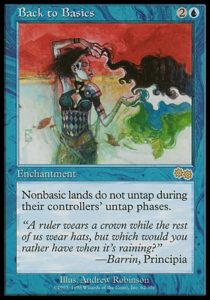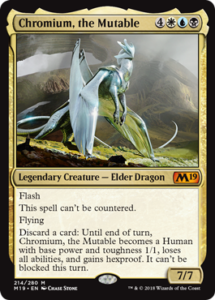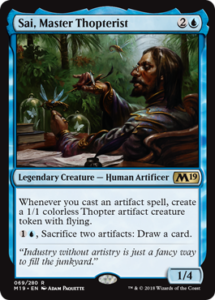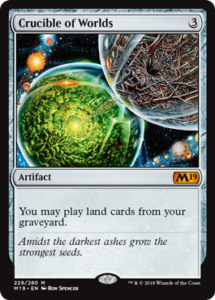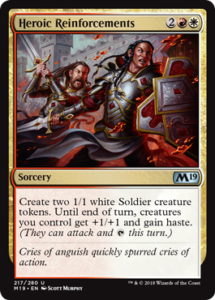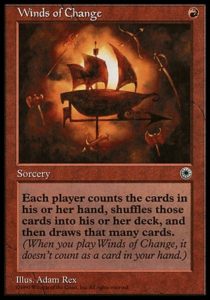For most of Magic, core sets were vehicles to keep or introduce cards to Standard. They were theoretically introductory tools, but having to support premier play meant that their complexity was usually too high for new players. Still, their focus on less experienced players made them less desirable draft formats for enfranchised players. For most of Magic, Core sets were restricted to only including reprints and often did things to deflate their value, such as having white borders or eschewing iconic artwork. Magic 2010 changed up the formula (and a whole bunch of rules) by giving core sets brand new cards and high fantasy themes. Magic Origins proved that a core set could tell enjoyable stories across multiple planes, utilize double-faced cards, and support solid Limited environments. And then, core sets stopped existing for a few years. Next weekend, this changes.
In a few weeks, Magic 2019 will make its mark on history. It’s the first set truly designed for introductory play—Portal was a solid experiment, but had a slew of issues—with its sister products (like the Deckbuilders’ Toolkit, introductory decks, and Planeswalker Decks) all designed in tandem with the product rather than after the fact. It’s also the first core set since Magic 2010’s paradigm explicitly not intended for enfranchised Limited players to play heavily.
Today, let’s talk about Magic 2019. It’s doing a whole lot of things correctly, treading both new and unfamiliar ground in exciting ways. It’s not a product for everyone, but it’s arguably the core set designed for the most distinct player types ever.
Commons and Uncommons for Newcomers
Unlike every core set since Magic 2011, there are zero non-evergreen keywords in Magic 2019. The set is designed with clear, simple themes. Complexity is mostly shifted to rare and mythic or hidden in lenticular cards. M19 has ten signpost multicolor uncommons, an innovation from Innistrad and Theros that works really, really well for telling players what to pay attention to. It has five monocolor tribes, tribal being a simple theme to grok and a popular one. The set has exceptional creatures like Bristling Boar and Knight of the Tusk that break rules to clue new players into how the rules of the game work.
There is an enormous amount of care put into this set to make sure that new players can learn and enjoy the game. As someone who’s taught perhaps a hundred people how to play Magic, I’m delighted by so much of what I see in Magic 2019. We’ll see how it plays, but the set has the potential to be the most effective introductory product ever.
Flavorful, Fantasy for Vorthoses
Magic 2019 introduces a whole swath of Magic’s worlds, giving new and returning players a window into Magic’s many planes while touching very, very gently on the plotlines. The goal overall is to invite players to want to know and see more rather than be cognizant of all that they don’t intimately know already. Having a cycle of Elder Dragon Legends lets new players be as excited for giant dragons as people were back in ’94, while also letting lapsed and long-time players have a connection spanning 24 years.
Rares for the Enfranchised
The rares in this set are insane. There are narrow targeted hate cards designed for nonrotating formats, like Alpine Moon, Amulet of Safekeeping, Isolate, Infernal Reckoning, and Mistcaller. There are relevant new tribal lords for Elves, Goblins, and Spirits. There are sweet new legends and cards for Brawl, Commander, and Cube. There are complex cards lacking the keyword reminder text you’d normally see in a core set. Interestingly, a majority of common creatures with flying lack reminder text—flying is definitely the most grokkable keyword, but I’m intrigued that they don’t have it, especially cards like Snapping Drake which have ample room for it. Vorthoses get extra goodies in neat story moments like Sarkhan’s Unsealing and One with the Machine.
Magic 2019 is designed for a shockingly diverse array of audiences and give the set a wealth of value. I’m thoroughly impressed by all of the work that went into designing the entire swath of rares. So many audiences are targeted, and so many individual designs only really function in a core set where the locales and flavor are highly flexible. This is outstanding work from Wizards R&D and demonstrates the power of Play Design.
Mythics for Everyone
Every single mythic in this set is sweet. There are five Planeswalkers (fairly narrow, but each is powerful and will invite people to crack packs). There are five Elder Dragons, which will excite Tammies/Timmies, EDH players, Brawl players, and potentially Spikes, and they even contain a sixth dragon Planeswalker. There’s Crucible of Worlds, Omniscience, and Scapeshift—three valuable cards in need of a reprint that won’t break Standard but will increase the value of a booster box. The ‘weakest’ mythics in the set are Apex of Power, Bone Dragon, and Resplendent Angel—they aren’t likely going to break anything, but they will get newer players and brewers excited (and two of them will be solid in Limited).
Limited
Thus far, I’ve been kvelling about Magic 2019, but this is where the big question mark lies. Historically, core sets have been less deep Limited environments. They have smaller possibility spaces, so it takes fewer drafts to see what the formats are capable of, and so they become stale faster. Core set shenanigans tend to be the simplest of the bunch, though we’ve been several core set designs be significant components of Iconic Masters and Masters 25 combos.
This year, Wizards has been explicit that Magic 2019 may be less deep for Limited than its forebears, as it was designed first and foremost as an introductory product. While the rares and mythics clearly have Standard, Brawl, Commander, Cube, and even Modern and Legacy in their sights, commons and uncommons are the lifeblood of Limited and those are all squarely meant for less enfranchised players. Yes, Magic 2019 will be featured at PPTQs and GPs (while pro teams are preparing for the Pro Tour), but it won’t need to withstand the intense scrutiny of a Pro Tour, as the summer PT is Team Constructed.
All this said, I’m skeptical, but I’m not convinced that the Limited format won’t be good. I’m a game designer—you playtest something to see how it works, you don’t draw conclusions without experimentation. Looking back, Magic Origins was a surprisingly deep format and Magic 2019 has many different deck options, ample fixing, and a wealth of removal, all of which can lead to sweet formats.
Time will tell how good M19 Limited is, how effective its targeted hate cards are, how impactful it will be on Constructed, and how good an introductory product will be. The set continues Magic’s trend of iterating on its products, reinvigorating products that might not have hit the mark in the past. The product might not be meant for me, but it certainly is meant for a whole host of audiences. And hey, even if my intuition is correct and the format isn’t for me, M19 could be a solid time to briefly step away from Limited, focus on Modern, and buy singles instead of crack packs. Then, I can return to the game in September refreshed and jam tons of Ravnica. Time will tell.
And, as always, thanks for reading.
—Zachary Barash
Zachary Barash is a New York City-based game designer. He works for Kingdom Death: Monster, has a Game Design MFA from the NYU Game Center, and does freelance game design. When the stars align, he streams Magic.
His favorite card of the month is Goblin Fireslinger. It’s brutally simple and quite weak but it just plays perfectly with Bloodthirst (which it was designed to do). And it can be surprisingly potent clock when games go long. It pulls a whole lot of work for a simple common.

